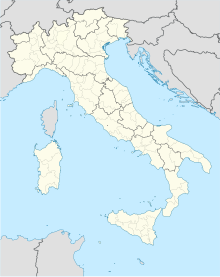
Friuli-Venezia Giulia is one of the 20 regions of Italy and one of five autonomous regions with special statute. The regional capital is Trieste on the Gulf of Trieste, a bay of the Adriatic Sea.
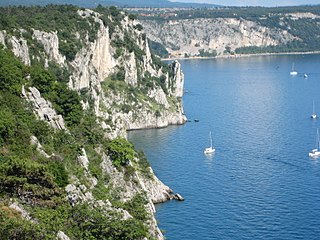
The Karst Plateau or the Karst region, also locally called Karst, is a karst plateau region extending across the border of southwestern Slovenia and northeastern Italy.

The province of Trieste is a province in the autonomous Friuli-Venezia Giulia region of Italy. Its capital was the city of Trieste. It had an area of 212 square kilometres (82 sq mi) and it had a total population of 234,668. It had a coastal length of 48.1 kilometres (29.9 mi). Abolished in 2017, it was reestablished in 2019 as the regional decentralization entity of Trieste, and was reactivated on 1 July 2020.
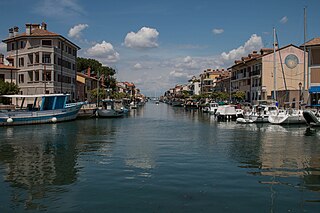
Grado is a town and comune (municipality) of 8,064 residents in the Regional decentralization entity of Gorizia in the north-eastern Italian region of Friuli-Venezia Giulia, located on an island and adjacent peninsula of the Adriatic Sea between Venice and Trieste. The territory of the municipality of Grado extends between the mouth of the Isonzo and the Adriatic Sea and the Grado Lagoon, and covers an area of about 90 square kilometers between Porto Buso and Fossalon. Characteristic of the lagoon is the presence of the casoni, which are simple houses with thatched roof used in the past by the fishermen of Grado, who remained in the lagoon for a long time, returning to the island of Grado only during the colder period of the year.

Grotta Gigante, also known as Riesengrotte or as Grotta di Brisciachi, is a giant cave on the Italian side of the Trieste Karst (Carso), close to the village of Borgo Grotta Gigante or Briščiki in the municipality of Sgonico. Its central cavern is 107 m (351 ft) high, 65 m (213 ft) wide and 130 m (430 ft) long, putting it in the 1995 Guinness Book of Records as the world's largest show cave. This record was broken in 2010 when La Verna cave in the south west of France was opened to tourists, measuring 255 by 225 by 195 metres.
Refosco is a very old family of dark-skinned grape varieties native to the Venetian zone and neighbouring areas of Friuli Venezia Giulia, Gavi, Trentino, Istria, and Karst Plateau. It is considered autochthonous in these regions.

Opicina, formerly Poggioreale del Carso in Italian, is a town in northeastern Italy, close to the Slovenian border at Fernetti. Opicina is a frazione of the comune of Trieste, the provincial and regional capital. The town has a large Slovene population, with Slovenian being widely used alongside Italian in private and public institutions. The first town near Opicina is Sežana in Slovenia, there is also the next railway station.

Doberdò del Lago is a comune (municipality) in the Regional decentralization entity of Gorizia in the Italian region of Friuli-Venezia Giulia, located about 30 kilometres (19 mi) northwest of Trieste and about 11 kilometres (7 mi) southwest of Gorizia, and borders the following municipalities: Duino-Aurisina, Fogliano Redipuglia, Komen (Slovenia), Miren-Kostanjevica (Slovenia), Monfalcone, Ronchi dei Legionari, Sagrado and Savogna d'Isonzo. It is located in the westernmost part of the Karst Plateau.

Savogna d'Isonzo is a comune (municipality) in the Regional decentralization entity of Gorizia in the Italian region of Friuli-Venezia Giulia, located about 35 kilometres (22 mi) northwest of Trieste and about 3 kilometres (1.9 mi) southwest of Gorizia, on the border with Slovenia. The name of the village comes from the Slovene word sovodnje, which means "confluence". Near Savogna, in fact, the Vipava river flows into the Isonzo at the conjunction of the Karst Plateau and the Vipava Valley.
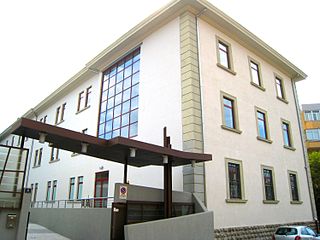
Civico Museo di Storia Naturale di Trieste is a natural history museum in Trieste, northern Italy. It contains several collections, including more than two millions botanical, zoological, mineralogical, geological, and paleontological specimens.
Terrano is a Slovenian and Italian wine variety, bearing the mark of recognized traditional denomination. It is a member of the Refosco family of grape varieties, which also includes Refosco dal Peduncolo Rosso. Since 2006 it is a wine with a protected designation of origin (PDO) within European Union under the protected designation "Teran".

The Rosandra Valley is a valley centered on the Rosandra River in the municipality of Dolina in the Italian region of Friuli-Venezia Giulia, between the city of Trieste and the border with Slovenia. It is part of a nature park, mostly set around the Rosandra River. The surrounding hills reach an elevation of 412 metres (1,352 ft). The northern end of the valley crosses the Italian-Slovenian border. The Rosandra Valley is part of the Karst geographical region. Tourist attractions in the valley are 40-metre (130 ft) Supet Falls near the village of Botazzo and Our Lady of Siaris Church perched high in the hills of the valley.
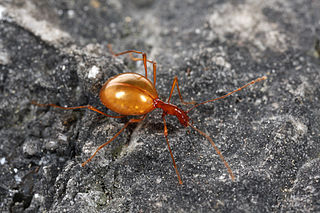
Leptodirus is a cave beetle in the family Leiodidae. The genus contains only the single species Leptodirus hochenwartii. It is a true troglobite, endemic to Slovenian, Croatian and, partly, Italian caves.
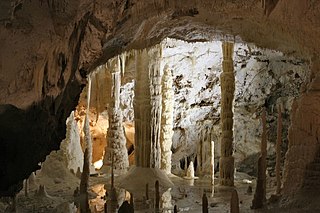
The Frasassi Caves are a karst cave system in the municipality of Genga, Italy, in the province of Ancona, Marche. They are among the most famous show caves in Italy.
Abisso Bonetti is a Karst cave in the municipality of Doberdò del Lago, 1 km (0.62 mi) SE from the small village of Bonetti, near Slovenian border. The cave is one of the most famous cavities in the Gorizia Karst. Anyway, due to its dangerous pit opening, entry is allowed only to expert cavers with the necessary equipment for single-rope descend.
Grotta dell'Artiglieria is a Karst cave in the municipality of Doberdò del Lago. The cave is located NE of Doberdob Lake, near the top of a small hill, in the small village of Jamiano. The name is referred to the artillery battery set in the cave during World War I.

Grotta del Gelo is a volcanic cave of Mount Etna which is known for the presence of a large amount of ice. The cave formed in 1614–1624 during a large eruption of the volcano, inside one of the lava flows produced during that eruption. Within the two subsequent decades, ice grew and accumulated in the cave. Today it is a tourist destination.

Monte San Michele (Italian) or Debela griža (Slovene) is a hill on the Karst Plateau, in the Italian province of Gorizia, on the border between the municipalities of Sagrado and Savogna d'Isonzo. It is located eight kilometres southwest of Gorizia, on the left bank of the Isonzo, and has four peaks, the highest two of which have an elevation of 275 meters above sea level, while the lowest has an elevation of 237 meters, and Cima Quattro stands at 264 meters.

Mount Cocusso is a mountainous relief on the border between Italy and Slovenia. It is the highest mountain in the Trieste Karst.

